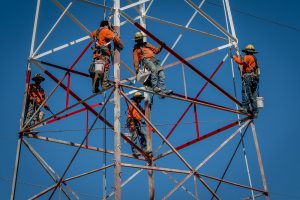PG&E has upwards of 46,000 transmission towers across its service area, and many of them were erected several decades ago. The company has identified 6,000 of these towers had been coated in lead-based paint, which was discontinued for residential use in 1978. In some cases, the lead paint on these towers is beginning to peel off, and PG&E has launched a large-scale proactive endeavor to re-coat all of its lead-based painted towers with a new, environmentally friendly acrylic-based paint.
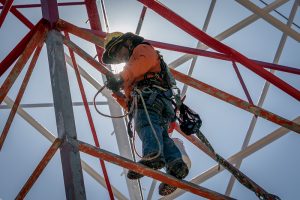 According to PG&E’s website, the first phase of the project is focused on towers that are in close proximity to homes, schools and parks, which accounts for a substantial percentage of the towers in question. The Utility Reporter caught up with a tower painting crew as they worked on a 115kv transmission tower located near a school in San Bruno, just across the freeway from San Francisco Airport.
According to PG&E’s website, the first phase of the project is focused on towers that are in close proximity to homes, schools and parks, which accounts for a substantial percentage of the towers in question. The Utility Reporter caught up with a tower painting crew as they worked on a 115kv transmission tower located near a school in San Bruno, just across the freeway from San Francisco Airport.
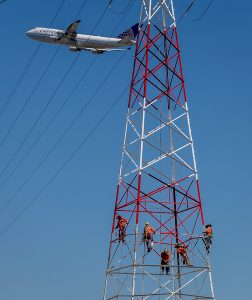 “The towers we’re doing here are being painted aviation red and white. [Since these towers are near the airport] they have to be painted these colors by spec,” Ken Meyer, working foreman B in PG&E’s Insulation and Coatings Department, explained. “We also do green towers and silver-gray towers, depending on what the location calls for. Most locations call for green because it blends into the environment more.”
“The towers we’re doing here are being painted aviation red and white. [Since these towers are near the airport] they have to be painted these colors by spec,” Ken Meyer, working foreman B in PG&E’s Insulation and Coatings Department, explained. “We also do green towers and silver-gray towers, depending on what the location calls for. Most locations call for green because it blends into the environment more.”
Meyer noted that PG&E is taking every precaution to preserve the environment throughout the course of the project.
“We have biologists that come out and walk the area down. There’s protected species here, so we want to make sure that we keep those species protected,” said Meyer. “We have had an environmentalist on site the entire time we’re working on these towers.”
 So how exactly do the crews remove and replace the paint while also protecting the natural resources that surround the towers? Meyer explained exactly what the process entails.
So how exactly do the crews remove and replace the paint while also protecting the natural resources that surround the towers? Meyer explained exactly what the process entails.
“We use HEPA vacuum cleaners, which are used to vacuum and remove peeling lead paint off the towers. Once we’ve completed the cleaning on the towers, we go up and spot-prime, and then we put a finish coat on the towers to encapsulate everything,” he said.
“We actually use a paint brush and a bucket. I know it sounds old-fashioned, but it’s quick, efficient and safe,” Meyer explained. “We lay tarps underneath the towers 20 feet out, in order to keep paint off of the ground. We don’t want any paint going into the environment.”
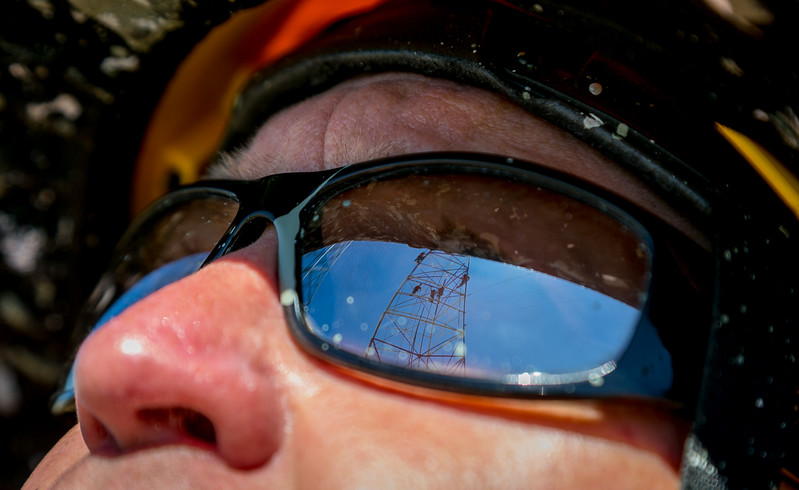
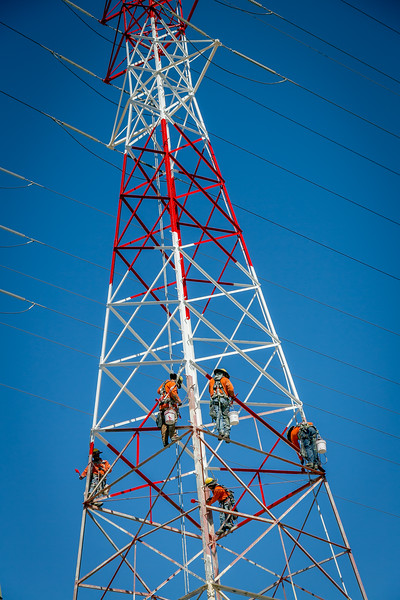

Front row - left to right; Chuck Kannal, Ken Meyer, and Angelo Figueroa. Back row - Gary Ribeiro, Gary Garcia, and Andy Hansen.









